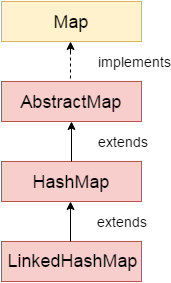Table of Contents
1. Đặc điểm
Những điểm quan trọng về lớp LinkedHashMap trong java cần nhớ là:
- LinkedHashMap lưu trữ dữ liệu dưới dạng cặp key và value.
- LinkedHashMap chỉ chứa các key duy nhất.
- LinkedHashMap có thể có 1 key là null và nhiều giá trị null.
- LinkedHashMap duy trì các phần tử theo thứ tự chèn.
2. Hierarchy của lớp LinkedHashMap

Lớp java.util.LinkedHashMap được định nghĩa như sau:
public class LinkedHashMap<K,V>
extends HashMap<K,V> implements Map<K,V> {
}
Trong đó:
- K: đây là kiểu key để lưu trữ.
- V: đây là kiểu giá trị được ánh xạ.
3. Các phương thức khởi tạo (constructor) của lớp LinkedHashMap
- LinkedHashMap(): khởi tạo một map trống.
- LinkedHashMap(Map<? extends K, ? extends V> m): khởi tạo một map với các phần tử của map m.
4. Các phương thức (method) của lớp LinkedHashMap
Xem thêm các phương thức của Map ở bài viết Map Interface trong java.
5. Ví dụ minh họa
5.1. Ví dụ sử dụng LinkedHashMap với kiểu dữ liệu cơ bản (Wrapper)
package com.maixuanviet.collection.linkedhashmap;
import java.util.LinkedHashMap;
import java.util.Map;
import java.util.Map.Entry;
public class LinkedHashMapExample {
public static void main(String args[]) {
// init map
Map<Integer, String> map = new LinkedHashMap<Integer, String>();
map.put(1, "Basic java");
map.put(2, "OOP");
map.put(4, "Multi-Thread");
map.put(3, "Collection");
// show map using method keySet()
for (Integer key : map.keySet()) {
String value = map.get(key);
System.out.println(key + " = " + value);
}
System.out.println("---");
// show map using method keySet()
for (Entry<Integer, String> entry : map.entrySet()) {
Integer key = entry.getKey();
String value = entry.getValue();
System.out.println(key + " = " + value);
}
}
}
Kết quả thực thi chương trình trên:
1 = Basic java 2 = OOP 4 = Multi-Thread 3 = Collection --- 1 = Basic java 2 = OOP 4 = Multi-Thread 3 = Collection
5.2. Ví dụ sử dụng LinkedHashMap với key có kiểu String, value có kiểu Student
package com.maixuanviet.collection.map;
public class Student {
private int id;
private String name;
public Student(int id, String name) {
this.id = id;
this.name = name;
}
@Override
public String toString() {
return "Student [id=" + id + ", name=" + name + "]";
}
public int getId() {
return id;
}
public String getName() {
return name;
}
}
package com.maixuanviet.collection.linkedhashmap;
import java.util.LinkedHashMap;
import java.util.Map;
import java.util.Map.Entry;
public class LinkedHashMapExample2 {
public static void main(String args[]) {
// Student's data
Student student1 = new Student(1, "Student 1");
Student student2 = new Student(2, "Student 2");
Student student3 = new Student(3, "Student 3");
Student student4 = new Student(4, "Student 4");
// init map
Map<Integer, Student> map = new LinkedHashMap<Integer, Student>();
map.put(student1.getId(), student1);
map.put(student2.getId(), student2);
map.put(student4.getId(), student4);
map.put(student3.getId(), student3);
// show map using method keySet()
for (Integer key : map.keySet()) {
Student value = map.get(key);
System.out.println(key + " = " + value);
}
System.out.println("---");
// show map using method keySet()
for (Entry<Integer, Student> entry : map.entrySet()) {
Integer key = entry.getKey();
Student value = entry.getValue();
System.out.println(key + " = " + value);
}
}
}
Kết quả thực thi chương trình trên:
1 = Student [id=1, name=Student 1] 2 = Student [id=2, name=Student 2] 4 = Student [id=4, name=Student 4] 3 = Student [id=3, name=Student 3] --- 1 = Student [id=1, name=Student 1] 2 = Student [id=2, name=Student 2] 4 = Student [id=4, name=Student 4] 3 = Student [id=3, name=Student 3]
Related posts:
Java Program to Check Whether Graph is DAG
Pagination and Sorting using Spring Data JPA
New Features in Java 11
Java Program to Implement the Hungarian Algorithm for Bipartite Matching
Error Handling for REST with Spring
Removing Elements from Java Collections
Java Program to Implement Hash Tables Chaining with Doubly Linked Lists
Wiring in Spring: @Autowired, @Resource and @Inject
Java Program to Perform Polygon Containment Test
Model, ModelMap, and ModelAndView in Spring MVC
How to Manually Authenticate User with Spring Security
Hướng dẫn sử dụng String Format trong Java
Guide to the Java Queue Interface
Command-Line Arguments in Java
Java Program to Implement Shunting Yard Algorithm
How to Get the Last Element of a Stream in Java?
Send email with authentication
Map Serialization and Deserialization with Jackson
Phương thức tham chiếu trong Java 8 – Method References
Java Program to Implement SimpeBindings API
Debugging Reactive Streams in Java
Spring Boot Configuration with Jasypt
Java Program to Check Cycle in a Graph using Graph traversal
Java Program to Implement Booth Algorithm
Java Program to Implement the One Time Pad Algorithm
Spring Boot - Enabling HTTPS
Java Program to Generate a Graph for a Given Fixed Degree Sequence
Registration – Activate a New Account by Email
Java Program to Implement Triply Linked List
A Guide to Concurrent Queues in Java
Guide to System.gc()
Spring Boot - Exception Handling

